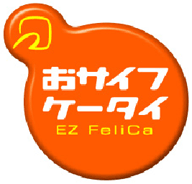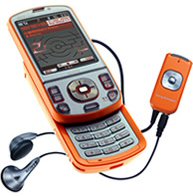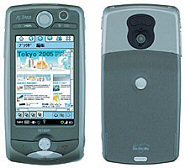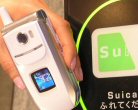KDDI Announces EZ-Felica Wallet Cell Phone Service
 Fresh off the news wire [Jpn], KDDI just announced they are ready to roll out wallet-enabled handsets for their new “EZ-Felica” campaign scheduled to hit the Ginza sometime this September. According to the company, they are street-testing the new BREW-based application program which will offer digital cash together with a range of membership services including loyalty points for registered users. But wait.. that’s not all! KDDI also announced that from January 2006, the company will enable customers to use “Mobility Suica” in partnership with East Japan Railway Company (JR) as well. It seems like only yesterday (actually, December 2003) we reported “KDDI Joins FeliCa Bandwagon”.
Fresh off the news wire [Jpn], KDDI just announced they are ready to roll out wallet-enabled handsets for their new “EZ-Felica” campaign scheduled to hit the Ginza sometime this September. According to the company, they are street-testing the new BREW-based application program which will offer digital cash together with a range of membership services including loyalty points for registered users. But wait.. that’s not all! KDDI also announced that from January 2006, the company will enable customers to use “Mobility Suica” in partnership with East Japan Railway Company (JR) as well. It seems like only yesterday (actually, December 2003) we reported “KDDI Joins FeliCa Bandwagon”.


 3G handsets are driving new phone sales as consumers toss older 2G models for the promise of more music, fun and games. The Nihon Keizai Business Daily reported statistics from the
3G handsets are driving new phone sales as consumers toss older 2G models for the promise of more music, fun and games. The Nihon Keizai Business Daily reported statistics from the  NTT DoCoMo has partnered with Motorola to roll-out a hybrid FOMA/PDA handset with global roaming, full Internet browsing, PC mail and wireless LAN access. Launched today at a low key Tokyo press conference, the new M1000 [
NTT DoCoMo has partnered with Motorola to roll-out a hybrid FOMA/PDA handset with global roaming, full Internet browsing, PC mail and wireless LAN access. Launched today at a low key Tokyo press conference, the new M1000 [ Mass transit meets mobile technology for Tokyo commuters in a new service enabling NTT DoCoMo FeliCa-equipped i-mode cell phones to function as Suica JR train commuter cards. The new service will combine DoCoMo’s FeliCa smart card e-money platform with the Suica IC train commuter card (both using technology developed by Sony) into one mobile handset that can simultaneously pay for train tickets, commuter passes, airline and movie tickets and purchases at any of 14,000 — and counting — retailers.
Mass transit meets mobile technology for Tokyo commuters in a new service enabling NTT DoCoMo FeliCa-equipped i-mode cell phones to function as Suica JR train commuter cards. The new service will combine DoCoMo’s FeliCa smart card e-money platform with the Suica IC train commuter card (both using technology developed by Sony) into one mobile handset that can simultaneously pay for train tickets, commuter passes, airline and movie tickets and purchases at any of 14,000 — and counting — retailers.